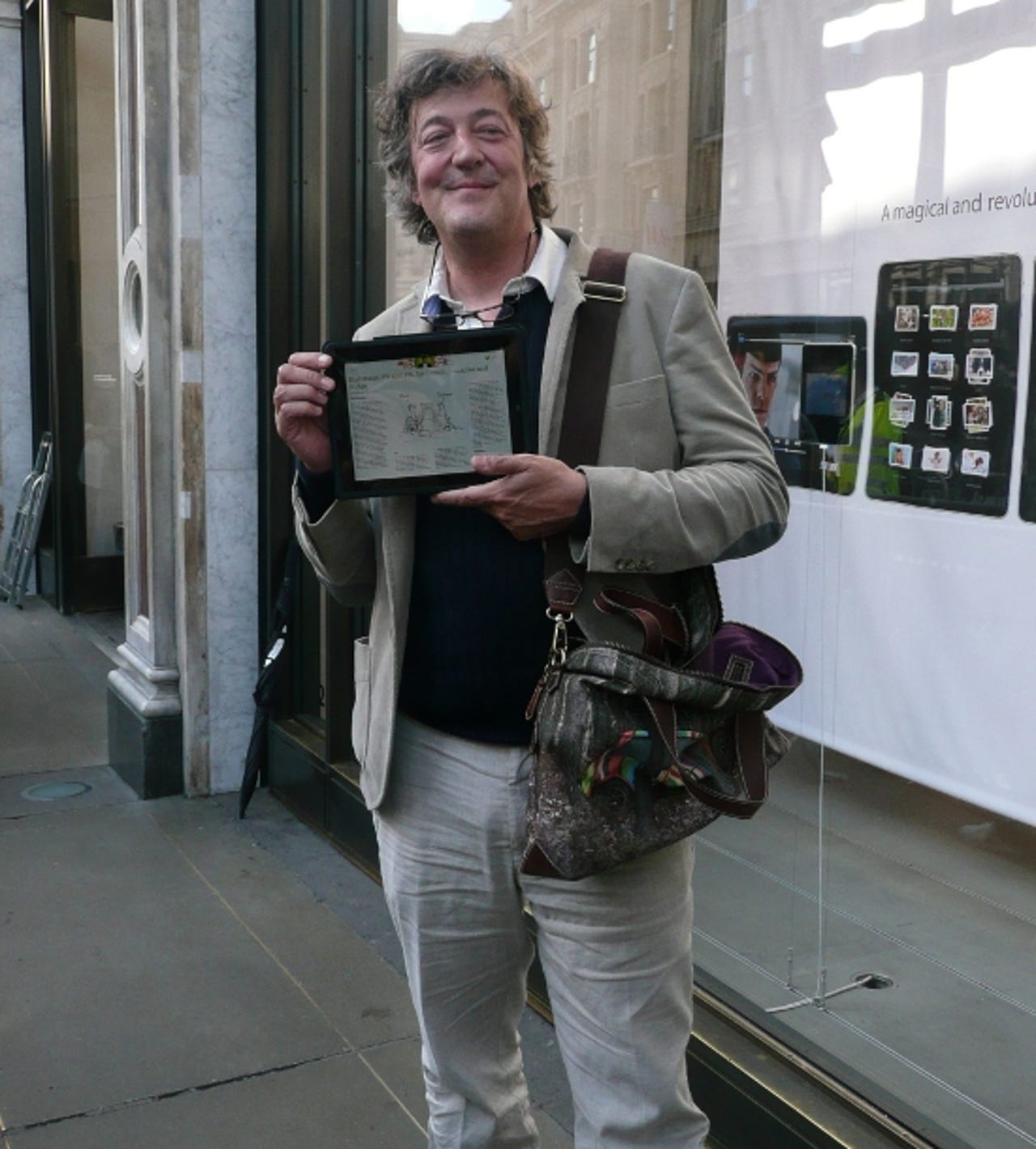Apple iPad UK launch, home of the future and new phones from Nokia, HTC


Photos of the month - May 2010
May was a big month for tech launches with Apple's iPad tablet finally released in the UK.
Hundreds of Apple faithful descended on the company's UK flagship store on London's Regent Street helping to push iPad sales over the two million mark in the two months since its US launch.
Among the Apple devotees picking up an iPad was Stephen Fry - see who else was in the queue on launch day here.
Photo credit: Rob Tomkinson/silicon.com
With a new Apple toy to play with, silicon.com's sister site CNET News.com took time out to compare how iPad apps measure up to their iPhone cousins.
Pictured above are the iPad and iPhone versions of eBay's app - showing how the iPad's offering gives a better experience when browsing item descriptions and checking out close-ups. But the iPhone version wins with push notifications for bidders, giving its users a heads-up if they are outbid on an item.
For more like-for-like comparisons of iPad vs iPhone apps, click here.
Screenshot: Josh Lowensohn/CNET
Also in May, silicon.com had a gander at some of the iPhone apps that use augmented reality - showing six of the best free apps in action.
Pictured above is Layar, an app for finding nearby points of interest. It uses augmented reality to show users various amenities in their vicinity, as well as how to get to them. Search results are overlaid onto the camera view in the form of a photo of each place, along with its address and distance from the user's current location.
To see the other five nifty apps check out the full photo story here.
Photo credit: Tim Ferguson/silicon.com
The iPhone may be shiny but it's no longer new. Shiny and new mobile hardware arriving on these shores last month included the Palm Pre Plus, pictured above - a refresh of Palm's webOS-based smartphone.
Tweaks to the Pre Plus include changes to the device's sliding mechanism and more clickable keys on its Qwerty keyboard.
You can find more more photos of the Pre Plus, and of the updated Pixi Plus, here.
Photo credit: Palm
Mobile behemoth Nokia also had a new smartphone to show off last month, the touchscreen N8 (pictured above).
The device will be the first to run Symbian^3 when the next iteration of the open OS launches later this year, albeit skinned with Nokia's own UI.
The N8 will also be Nokia's first to support multitouch gestures such as pinch to zoom and kinetic scrolling, and will launch later this year.
For more photos of the N8 click here.
Photo credit: Nokia
Another new smartphone was announced by HTC: known as the Wildfire, the device features the company's Sense user interface and runs Android.
With the HTC Friend Stream application, shown above, the Wildfire collates information from sites including Facebook, Twitter and Flickr, to provide a single stream of social network updates.
See more pictures of the HTC Wildfire in the full photo story here.
Photo credit: HTC
Handheld hardware wasn't the only kit cropping up in May: Samsung showcased some of the gear coming out of its new IT business unit, including the multimonitor pictured above - a massive display unit consisting of six 23-inch screens.
There's more Samsung kit, including an all-in-one PC and an e-book reader, here.
Photo credit: Jo Best/silicon.com
Meanwhile, Microsoft's Cambridge research lab opened its doors to show off the experimental tech its researchers are working on.
One of the projects is this back-up box, pictured above - part of a project exploring how people might pass on digital possessions and ephemera to loved ones. The back-up box logs all of an individual's tweets and status updates, and stores them for later viewing.
See what other technologies Microsoft is cooking up in the photo story here.
Photo credit: Tim Ferguson/silicon.com
More research tech was under the microscope last month after silicon.com senior reporter Nick Heath took a trip across the pond to visit the Massachusetts Institute of Technology (MIT).
Researchers demoed a low-cost system they have developed for gesture-based computing that relies on a pair of multicoloured gloves (shown above), an off-the-shelf webcam and a desktop PC running software written by MIT staff.
You can see more pictures of the system in action here.
Photo credit: MIT
In the future, researchers at the Massachusetts Institute of Technology believe doctors and their patients will be in touch 24/7.
Another system developed at MIT, called Collaborhythm, aims to use touchscreen displays, mobile devices and avatars - such as the one pictured above - to give patients more say in how they are treated.
Find out more about how doctors could be dishing out treatment in future here.
Photo credit: Nick Heath/silicon.com
As part of the Grand Designs Live show, which took place at London's Excel centre last month, Philips showed off its vision for the house of the future - including new ways to power gadgets.
Shown here is technology devised by WiPower, which uses a transmitter located underneath the table to wirelessly power items on the surface - in this case, lightbulbs.
There was plenty of other interesting tech on show - and you can see it here.
Photo credit: Tim Ferguson/silicon.com
May was also the month when more than 5,000 developers converged on the Moscone Center in San Francisco for Google I/O, where the search giant laid out its ideas for the future of the web.
The star of the show had to be Google's smartphone OS Android. This glass case, pictured above at the conference, displayed dozens of mobiles running the Android operating system.
For more from the floor of Google I/O, see the full photo story.
Photo credit: James Martin/CNET
Microsoft also had a raft of software announcements in May - including the official launch of Office 2010.
Want a shortcut on what to expect from the updated productivity suite? This photo story covers off updates to the new look Word, including its revamped Navigation Pane (shown above), Outlook, Excel and more.
Photo credit: Microsoft
Microsoft took the wraps off Office Mobile 2010 too - its updated productivity suite for smartphones.
Tweaks include the ability to control a PowerPoint presentation using a Windows Mobile 6.5-based smartphone - via PowerPoint Mobile 2010's Presentation Companion feature.
Once a Windows Mobile 6.5 phone is connected to a PC through Bluetooth, PowerPoint Mobile 2010 (shown above) can be used to advance slides in a presentation and also view presentation notes.
For more screenshots of Office Mobile 2010 click here.
Image credit: Microsoft
And Redmond still found time to announce a forthcoming refresh to its consumer email product, Hotmail. The new version is to be rolled out to most users in July or August this year.
One of the new features of Hotmail is the addition of the browser-based Office Web Apps. The apps allow Office documents, such as the PowerPoint presentations pictured here, that are sent to Hotmail to be opened without the recipient needing their own copy of Office installed.
For more on Hotmail's new features click here.
Photo credit: Microsoft
The BBC had a big software refresh up its sleeve too - unveiling the latest version of its online TV service iPlayer which includes new functionality to improve the user experience and make it more social.
The feature shown above allows users to recommend and comment on content to their friends in iPlayer but also via Facebook and Twitter.
There were plenty of other features in the beta version - find out more in this photo story.
Screenshot: bbc.co.uk/iplayer by silicon.com
Updates were also on Facebook's mind last month. The social networking site changed its user privacy settings system in response to criticism by users that its existing system was over-complicated. Facebook's new privacy settings replace the wall of text with a more visually pleasing chart.
The chart itself is a static image, changeable only by hitting one of the presets or the small 'Customise' text link below the chart. Choose Customise and you can further restrict your privacy settings, to either specific friends or just yourself. Most major privacy tweaks are now on this one page.
For more on the Facebook privacy tweaks, click here.
Screenshot: Facebook by Seth Rosenblatt/CNET
May also inspired silicon.com sister site CNET News.com to take a look at how tech can help the earth, including through the sodar (sonic detection and ranging) wind measurement system shown above.
See more examples of green tech in the full photo story here.
Photo credit: Second Wind
Believe it or not, this is a cyber café in a shipping container now making its way to Kenya.
Computer Aid International - which reconditions unwanted computer equipment to be sent off to developing countries - recently branched out to provide the solar-powered cyber cafés.
The cyber café is powered by six solar arrays (shown above) which supply more than enough power to keep the computers running for a 12-hour day.
Photo credit: Rob Tomkinson/silicon.com